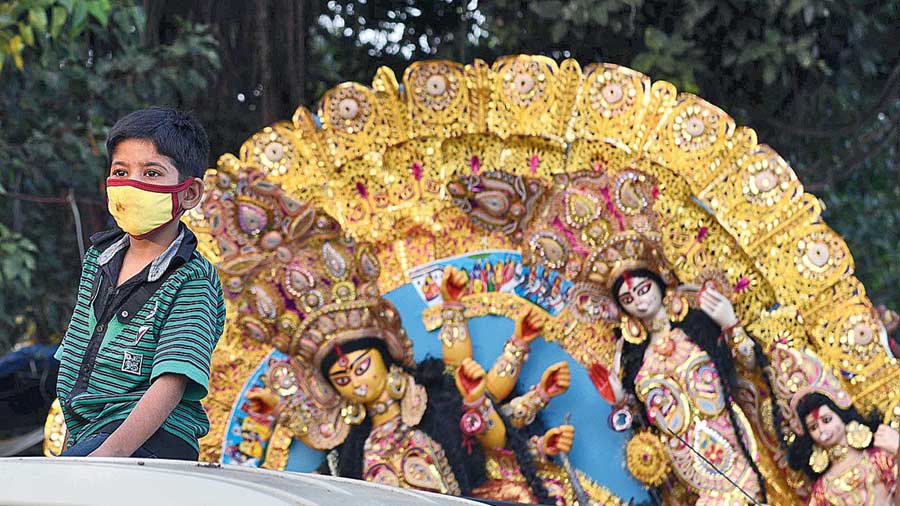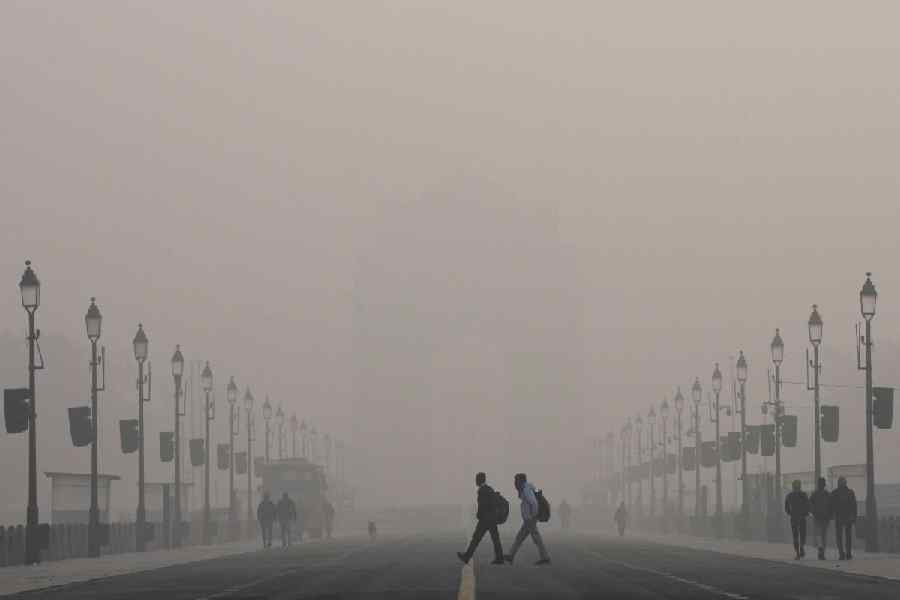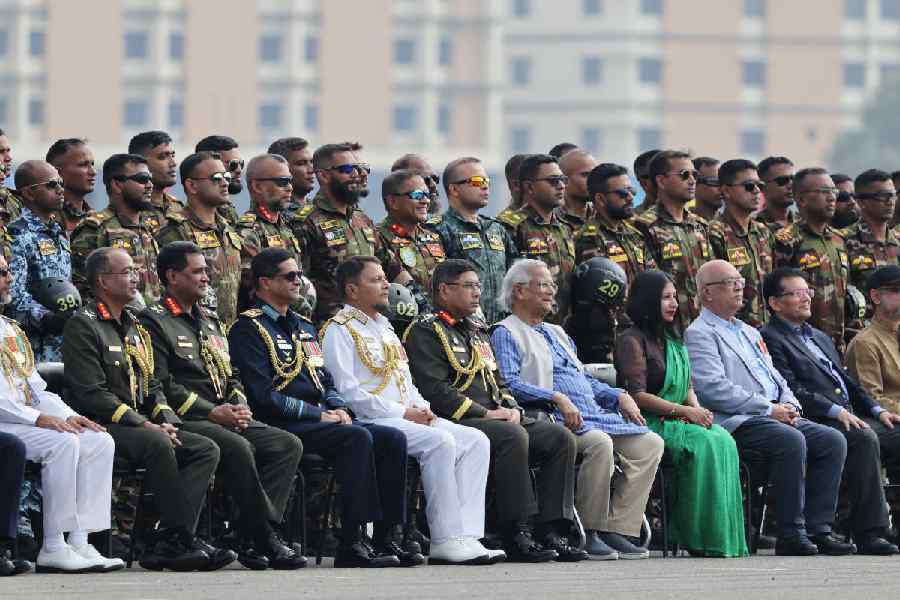Faces half hidden behind masks, streets with no crowds to manage, exchange of Vijaya greetings without the traditional embrace — Calcuttans are fervently praying that the “new normal” that cast a pall on Durga Puja 2020 fades away before the deity’s next sojourn.
This year’s Puja was unique in many ways — because of Covid-19 — and many felt that the uniqueness had marred the revelry. The Telegraph depicts how Calcutta’s Durga Puja looked and felt this year amid the pandemic.
Crowd
Far fewer people compared with previous years stepped out this Puja — the lanes leading to some of the pandals were almost empty — possibly because of a Calcutta High Court order preventing the entry of visitors into pandals. Even on Ashtami and Navami evenings, the crowds outside pandals were barely 10 per cent compared with other years. The roads were almost empty on Sashthi and Saptami.
“I think people thought after the high court order that no idol could be seen this year. In a couple of days, the word spread that some idols were visible from a distance. That drew some people to pandals,” said Avishek Bhattacharya, the general secretary of Tala Barowari. “But even at its peak, the crowd was less than 10 per cent of other years.”
An organiser of Shib Mandir Sarbojonin said: “The turnout was in no way comparable with previous years”.
The idols of both these pujas were visible from beyond the barricades, put up at 10m from the pandals as directed by the court.
Role of leaders
Many felt that leaders across the political divide could have done better by asking people not to step out. Chief minister Mamata Banerjee was heard asking people to watch the puja parikrama telecast by TV channels, instead of visiting pandals. But many other leaders, some of who organise big-ticket pujas, expressed disappointment at the high court’s order.
A refrain among most organisers was that they could not ask people to stay away from pandals.
Anirban Dalui, a doctor at the Rampurhat Medical College and Hospital and a public health specialist, called out this attitude of the organisers. “Whoever felt that asking people to step out during Puja was alright was just being irresponsible. Public health measures demanded that organisers did not publicise their pujas and made it less attractive this year,” said Dalui.
Virtual anjali
Many pujas installed extra loudspeakers strategically so that the Ashtami anjali mantras reached all homes in the locality. The organisers of Badamtala Ashar Sangha kept urging residents to chant the mantras from home. Maddox Square, too, asked residents to offer anjali from home. Residents of some apartment complexes logged in through Zoom links to see the priest perform the anjali rituals and repeat the mantras after him sitting at home.

A masked boy accompanies a group on its way to the immersion of a Durga idol at Babughat on Tuesday. Pradip Sanyal
Immersion
Most pujas immersed their idols by Tuesday, unlike previous years when most big-ticket pujas used to take part in a carnival on Red Road on the last day of immersions. Chief minister Mamata Banerjee had announced that there would be no carnival this time because of the Covid-19 pandemic.
Among the north Calcutta pujas, Ahiritola Sarbojonin immersed their idols on Monday and Maniktala Chaltabagan, Hatibagan Sarbojonin, Kashi Bose Lane and Nalin Sarkar Street Sarbojonin immersed their idols by Tuesday, police said. In south Calcutta, Babubagan, Ekdalia Evergreen, Singhi Park and Tridhara Sammilani immersed their idols by Tuesday.
Most of these pujas used to take part in the carnival.
Immersions will be allowed till Thursday.
Metro Railway
Metro Railway ferried lakhs of revellers during previous years’ Puja. This year it did not run the usual number of trains, thereby limiting the crowd.
From Saptami to Dashami, there were 64 trains every day. Last year, 244 trains ran every day from Saptami to Navami and 132 on Dashami. The passenger count was a little over 1.16 lakh on the four Puja days this year, said an official. Last Puja, it ferried close to 26 lakh passengers.
Unlike last year, when the service continued through the night, the first and last trains left the terminal stations at 10am and 9pm this year.
Stations like Kalighat and Dum Dum, usually the most crowded on Puja days, had only a handful of passengers.
Restaurants
The only outing for many was lunch or dinner at a favourite eatery. Around 2pm on Navami, the average waiting time outside Mocambo was over 30 minutes. Most restaurants extended the closing hours beyond midnight on the Puja days. Shiladitya Chaudhury, the owner of Oudh 1590, said people waited for lunch and dinner outside his restaurants on all four days. “The number of takeaways went up compared with last year,” he said.
Finding a parking slot on Park Street was tough like good old days.
A Salt Lake resident found a thick crowd outside a Kolaghat restaurant where she had gone to dine out with her family. She dropped the plan. “I would have caught Covid-19 had I stepped out in that army of people,” said one of them.
App cab and taxis
Fewer people on roads meant that commuters were spared astronomical surges in app cab fares, which used to be a common complaint during the Puja in previous years. Same with yellow taxis — they only asked for “a little extra” over the meter reading.
“I went to New Town from Kasba on Sashthi and came back on Ashtami. On both days, Uber charged me a little less than Rs 300. It was lesser than what I used to pay on a non-festive day during pre-Covid times,” said a Kasba resident.
The number of app cabs on roads has reduced since the pandemic started as passengers dwindled. Even with fewer cabs, the fare surge was comparatively less.
A taxi union leader said only 5,000 yellow taxis, out of 12,000 vehicles, ran during the Puja.
Traffic
From Tallah to Tollygunge, or from Behala to Salt Lake, no one was stuck in a snarl at any time of the day. “It was a smooth sail on all four days,” said a Calcuttan. Officers of Calcutta police’s traffic department, too, said vehicles were fewer compared with previous years.












